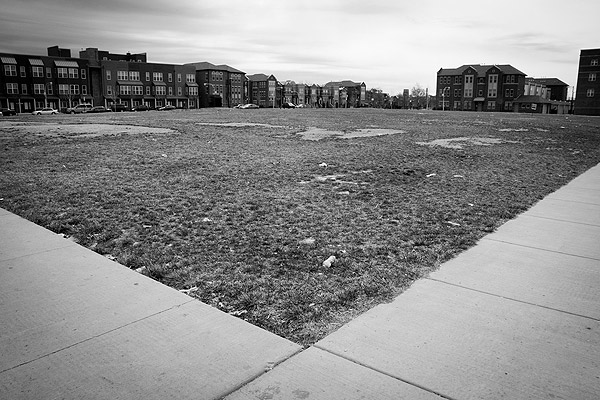
A new study co-authored by Edward Glaeser, author of The Triumph of the City, looks at declining segregation in American cities, Chicago prominent among them in both segregation and its decline; it bears the somewhat overoptimistic title "The End of the Segregated Century." In an accompanying article for Bloomberg, Glaeser describes the downturn in racial segregation as a triumph of public policy, and brings up some good—and frequently neglected—points about how cities like Chicago became as segregated as they are:
A core economic idea is that people pay higher prices when their choices are limited, whether those limits come from tariff barriers or racial restrictions. Thirty-five years ago, the economists John Kain (one of my mentors) and John Quigley found that blacks paid more than whites for comparable housing. My work with Cutler and Vigdor found that before 1970, the price and rent premium paid by blacks increased in more segregated areas, as you would expect of a group that had a more limited set of housing choices.
In short, redlining, restrictive covenants, and intimidation raised prices for urban blacks, one of the stories that runs through out Beryl Satter's lengthy examination of postwar housing in Lawndale, Family Properties. Segregation wasn't the only result; capital flight and destabilization also followed. But that began to change, and not all the reasons are positive:
After 1970, however, that pricing pattern switched. By 1990, blacks were paying less for housing than whites, especially in more segregated metropolitan areas. This switch can be explained if segregation, post-1970, reflects white preferences rather than barriers preventing black mobility. If the segregation that remains is the result of whites liking to live in primarily white neighborhoods, then we should expect whites to pay a price for limiting their own choices, and that is exactly what the data show.
But the more recent story in civic outmigration is the "reverse Great Migration," the big story that came out of the 2010 Census data, which was reflected in Chicago's declining black population—a migration not just back to the South, but the Sun Belt and even as close as the collar counties:
Chicago lost a hefty 200,000 residents in the last decade, most of them African-Americans, while suburban counties grew dramatically in numbers and diversity, according to 2010 census data released Tuesday.
[snip]
"I think these data from here and elsewhere in the country reflect that the United States has become a suburban nation," said Scott W. Allard, a University of Chicago associate professor of social service administration. "It is a continuing migration from the city out to the suburbs while there are also immigration waves directly to the suburbs as well."
Which is exactly what Glaeser found more broadly in the study itself:
The depopulation of ghettos has been driven not only by the “pull” factors of suburbanization and Sun Belt weather but also by the reversal of past public housing policy. Massive housing projects built at the peak of urban segregation, such as Chicago’s Robert Taylor Homes, were demolished over the past decade— following on the earlier destruction of other notorious projects, including St. Louis’s Pruitt-Igoe complex. The Robert Taylor Homes were constructed with an express purpose of perpetuating segregation, separated from traditionally white neighborhoods on Chicago’s South Side by the massive Dan Ryan Expressway. The highrise project occupied several census tracts; one of these tracts registered 1,532 residents in 2000—99.1 percent of them African-American—and exactly zero in 2010. More broadly, the set of census tracts with black shares of higher than 80 percent experienced an average population decline of 3.6 percent over the past decade—even as the nation’s population grew by nearly 10 percent. The number of such tracts declined as well—for reasons to be discussed below.
[snip]
At mid-century, during the peak decades of black migration, existing neighborhoods in numerous cities “tipped” rapidly from predominantly white to predominantly black. Migration to the Rust Belt slowed significantly after 1965, as manufacturing employment reached its historic peak. Through subsequent periods of decline and renewal, it has been very uncommon for black neighborhoods, once “tipped,” to “un-tip.” Depopulation, rather than subsequent ethnic or racial change, has been the dominant demographic change in the ghetto since 1970.
On a country-wide level, the decline of segregation is something to be celebrated. Glaeser is right that the difficult fights over restrictive housing have borne fruit in both explicit policy and implicit culture. But as Glaeser adds in his Bloomberg analysis of his study, what's a triumph for one place is a failure in another:
Much of the decline reflects relatively well-educated black Americans moving into white districts. While that freedom is something to celebrate, the exodus of the more skilled left many urban neighborhoods behind, and the effect of growing up in a segregated community appears to have gotten worse over time.
Chicago's decline in segregation seems to represent failure as much as success. Much progress has been made since postwar housing policy and ingrown racial hostility fed segregation through 1970, but its decrease has as much to do with the blowback from those years and the parallel failure of public policy, in the form of public housing, as it does with falling legal and economic barriers to integration. As Steve Bogira observed in "Separate, Unequal, and Ignored," a Reader piece on the absence of segregation as an issue in the most recent mayoral race, the distribution of African-Americans in Chicago hasn't really changed all that much in the past 30 years. Other cities appear to have learned from our mistakes, but that's much less of a policy dilemma than fixing decades of them.
Photograph: vxla (CC by 2.0)


